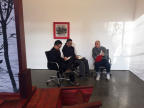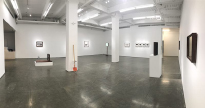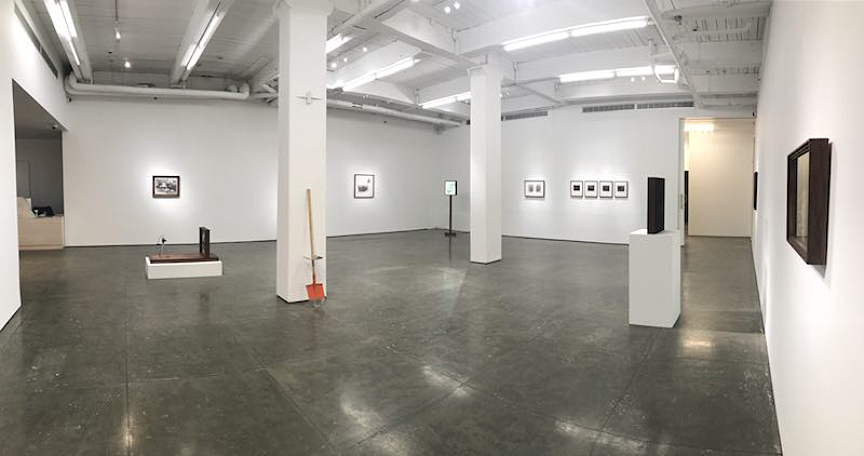|
|
. |
eChinaArt.com Presentation |
. . .  |
 |
||||||
作品推荐
Editor's Recommendation
|
Chinese Media Artist Cai Dong Dong |
|||||||||
中国媒体艺术家专栏 |
||||||||||
|
. |
“行走在误区” |
中华艺术网纽约凯尚画廊蔡东东,蔡正访谈 |
Walking in a Confusing Area |
An Interview with artist Cai Dongdong and Mr. Phil Cai, the gallery manger at Klein Sun Gallery in Manhattan |
Dialogues between artist Dongdong Cai, gallery manager Phil Cai and the eChinaArt.com executive director Dr Gan Yu on Dec 12, 2017, interview continued through emails from Jan 6 to Feb 2, 2018 eChinaArt.com: The exhibition you held for artist Dongdong Cai is clearly sensational, and indeed, these artworks merged themselves with social realities. Is this your main idea that emphasizes the relationship between art and society? Phil Cai: First of all, thank you for the kind words on the Cai Dongdong show. To me, all good art connects strongly to the human landscape. I’d even define contemporary art as the process of abstraction from our society whether it is a political movement or it is the artist’s worldview towards an event that happened forty years ago. What makes Cai’s work unique is that it seemingly only makes reference to a certain period of time in Chinese history. However it resonates strongly and differently with people from different backgrounds. eChinaArt.com: Phil, could you please briefly talk about the next promotion plan or market strategy for Mr. Dongdong Cai’s artworks? Phil Cai: We usually host an exhibition for every one of our represented artists every two years. This is industrial standard because two years is a reasonable time to revisit an artist’s market, style, development and etc. With some artists we would recommend strong evolution or development in style, but given Cai Dongdong’s situation we’d like to do so very gradually. His style is so unique among Chinese artists and we’d love him to keep doing what he’s been doing for some years before discussing drastic changes. He’s gaining importance both in the US and Europe. With more institutional recognition in the foreseeable future, I’d say Cai’s career is heading in a direction that fits him the most and we are excited about it. eChinaArt.com: As the manager of the Klein Sun Gallery-a gallery known for its support and focus on Chinese contemporary art, how would you posit Chinese contemporary art in the U.S.? Phil Cai: First, I think Chinese contemporary art is in its very beginning stage. Euro-American contemporary art is viewed as the majority in New York or the U.S. On the other side, Chinese contemporary art in the U.S. lacks a certain level of attention, collection, and museum recognition. In recent years, it has been rising, but it still takes a long time to grow. From a gallery's perspective, "Chinese contemporary art" underscores the element of being "Chinese." Most people visited our gallery just because it’s “China." Galleries make change according to market demands - there is nothing wrong with it - we select artists who carry "Chinese marks" or "Chinese labels." We keep this as a rule. But, also, as we've discussed before, what is more possible, is to switch our goals from seeking float-on-the-surface Chinese labels to more profound ones. For instance, in the past, a Chinese element could be the Tiananmen Square, the national flag or some sorts of media featuring China, but with thicker and broader understandings of Chinese contemporary art, a Chinese label would be Zhuangzi's thoughts or the influences of collectivism on Chinese society and decades of people. All considered this label will be crucial enough to relocate/redefine Chinese contemporary art for now and future. eChinaArt.com: Does the economic development in China match with its global market of contemporary art, considering speed-wise and size-wise? Phil Cai: Quantity-wise, it doesn't. China would possibly become the number one economy soon. Chinese traditional art or modern art has been ranked as the most trading volumes in the world for years. But speaking of Chinese contemporary art only, neither its trading volume nor attention weights a lot. But its growth rate stands for it, that its potential is enormous, and it will go farther than the country's economic growth. In the past few years, with the entries of some internationally famous auction houses into mainland China, many galleries and art companies realized the high potentials of Chinese contemporary art and entered Beijing or Shanghai one after another. eChinaArt.com: I know you have three-year work experience in a major auction house in New York before coming to Klein Sun, so if we say, taking New York as an example, has the market of Chinese contemporary art been established here? How would you describe the size of its collection market compared to that in the cities like Beijing or Shanghai? Phil Cai: In my opinion, the market of Chinese contemporary art has not yet been established. Let's just focus on contemporary art. Both Sotheby's and Christie's hold annual Asian week, and both have sale nights for Asian art, but that's all. The trading frequency of secondary market is a crucial index to measure the maturity of an art market, while Chinese contemporary art still means little on it. This fact also points out the essence of our gallery, that to expand the primary market of Chinese contemporary art, to increase the attention and in the meanwhile, and simultaneously, to uphold a secondary market platform for its trading. eChinaArt.com: The Market of Chinese art, especially the contemporary Chinese artworks is not very exciting compare with the past years, and someone suspected this may be the beginning of turmoil, even crash of the Chinese contemporary art era. Do you believe this kind of hypothesis? If not, could you be able to forecast the direction of the Chinese contemporary art market in the years to come? Phil Cai: Even though the contemporary art market is extremely hard to predict, I don’t think Chinese contemporary art will crash on its own drastically. Chinese contemporary art contains so so much and it holds so so much. There will be clearer and clearer categorization. To give an example, Lian Zhou museum is being established right as I write this interview who will specialize in photography. K 11 and Videotage have been hosting shows only to promote video art. Any specific categories might fall or take dips in the future and lots of them will, but Chinese contemporary art in general will not in my opinion. It will only gain importance as China opens up more and catches up with the West economically. To quote our artist Shen Shaomin who spoke at the newly founded Shen Zhen biennale: “John Adams said he must study Politics and War so my sons may have liberty to study Painting, Poetry mathematics and Philosophy. We did it. And we can now pursue arts with no regrets.” I completely agree with him and China’s time for art has come. eChinaArt.com: Does the Klein Sun Gallery have any motivation to expand their investment efforts inside China in the coming years? Phil Cai: Not in the near future. Each gallery has its own positioning. We are positioned here in New York as a unique promoter and dealer of Chinese contemporary art and we’d like to keep working as one for the near future. |
Interview of the Artist Cai Dongdo |
eChinaArt.com: Both your book and your exhibition were named as Quan (A Fountain). Could you briefly explain it? Cai Dongdong: This book contains a wide range of my photographic works throughout recent years. It was indeed very hard to come up with a symbolic name for all of the works as a collection, but I eventually decided to name it after one of my artwork, Quan, which also became the book's cover. Also, as I've just started to practice this kind of art, the name embraces a good wish for my future creation. eChinaArt.com: It seems like you prefer to scrub photo surfaces, reducing the resolutions, breaking the original status and sense of beauty of the photos. Would you explain to us what are the intentions behind such practice? Cai Dongdong: My original intention was to reuse/recycle the old objects. I have taken over ten thousand of photographs in the past decade, and I became aware of the ineffectiveness of these pictures in the digital era. I then started to destroy them, while the original method was to polish the photos till some parts disappear or to tear them apart. Then I found my interest through the actions of destroying, initiating art practice in such method. Indeed, the intention also fits well with my new understanding of images. eChinaArt.com: You see a photograph as a lie: to deceive the audience through "beautiful "images. Do you think all those masterpieces in photography's history are also lies? If so, what's that for? Cai Dongdong: Instead of using the "beautiful" or "aesthetically pleasing" as a strategy to bring audience's attention, I think it is the "reality" that comes out of photographs which deceives people. I remember in the early history of photography, one of photography’s inventors dressed up himself as a corpse and took a picture of it. A corpse is at the core of an image, but the intention behind this photo was not about the dead body but derived from the artist's confidence. So it's not a lie to me. eChinaArt.com: What you were saying is, if the audience appreciates the visual effects or artistic conceptions presented by a photographer, then they have stepped into a wrong path that misled by the photographer's lens. Then, why would these objects be considered as fake through the lens? Cai Dongdong: The American photographer Diane Arbus once said, "a photograph is a secret about a secret. The more it tells you, the less you know." All the photographers work for the joyful moments satisfied our eyes, such deception existed in photography might also see its charm. The objects in the lens are the objects in the photographer' eyes, featuring selectively from the photographer to the audience, or from the objects to the photographer. eChinaArt.com: How to make it happen if you don’t want to make images mislead the audience? Or how to make it happen to ask the audience to see something realistic? Cai Dongdong: When we observe an image, we should see it as a corpse, either eliminating its charm or avoiding seeing it. It burns your energy to appreciate a picture… eChinaArt.com: After you've collected approximately fifty to sixty thousand of old photos relevant to China, do you think it is also a myth to consider this collection as a part of contemporary Chinese society and culture? How shall we confront the happened video art history? Cai Dongdong: I have been organizing them and regarding them as fragments of images, much less than real partial of social or cultural history. Many photographs from the 1960’s to 1980’s are fake–people smiled to the camera for they were asked to do so. On the other side, my intention is to reveal such fakeness. I hope the audience could see through the surfaces, and catch such reality, even just for a moment. |
. |
中华艺术网蔡东东,蔡正访谈 |
| 我们非常高兴能与纽约曼哈顿凯尚画廊经理蔡正先生及艺术家蔡东东先生交谈,以下是此次访谈内容: 中华艺术网: 请问蔡正先生,此次在纽约凯尚举办的中国当代艺术家蔡东东的个展非常成功,呈现了很好的视觉与文化效应,的确,这些作品结合了一些社会现状。那么,您是有意在这个展览里强调艺术与社会的关联吗? 蔡正:首先,谢谢您对蔡东东个展的高度评价。对我而言,好的艺术作品与人文景观密不可分。我常将当代艺术比喻为一个抽象化社会的过程,无论是对一场政治运动的提炼,还是艺术家自己对四十年前某个历史事件的观点。蔡东东的作品之所以脱颖而出,是因为其看似只是取材于或者说指向中国历史上某个特定时期,但却能让来自不同文化背景的人产生强烈又各异的共鸣。 中华艺术网: 蔡正先生,您能简短地讲述一下关于蔡东东作品的下一步市场策略或走向吗? 蔡正: 通常情况下,我们会为所代理的艺术家每两年举办一次展览。依照行业标准,两年是一个比较合理的时间间隔去重新审视一个艺术家的市场,艺术风格,个人发展,等等。对于一些艺术家,我们会建议一些风格上的重大的转变,但基于蔡东东的情况,这种改变在他身上会体现得更循序渐进些。在所有中国当代艺术家中,他的艺术风格独树一帜,因此,在考虑重大的风格变化前,我们乐于支持他坚持了多年的现有风格。目前蔡东东在美国和欧洲都越来越被重视,有越来越多的机构认可他和他的作品。在能预见的未来中,我认为蔡东东的艺术之旅正在朝一个最适合他自己的方向展开,而我们也为此感到振奋。 中华艺术网: 作为以推动中国当代艺术和代理当代艺术家为主的凯尚画廊经理,你是怎样在美国定位中国当代艺术? 蔡正: 首先,我认为中国当代艺术,还处在一个比较启蒙的阶段,还是一个非常小众的领域。欧美的当代艺术在纽约或者说在美国占据着主导地位,而中国当代艺术无论从关注度,收藏度,美术馆认识度上,都是极为缺少的。近几年上升势头明显,但在我看来还需要很长的时间。作为画廊来看, “ 中国当代艺术” 其关键词还是在“ 中国” 上。究其原因为什么很多人会慕名来我们画廊,绝大多数是冲着“ 中国” 而来。画廊迎合市场需要,这是不可厚非的,因此我们也会选择能看的出“ 中国痕迹” 或者“ 中国标签” 的艺术家。这一点我觉得不会改变。但像我之前和您聊起过的,可能会出现的,是从找浅显的中国标签到找深层的中国标签中的转移。举个例子来说,从前的中国标签可能是一个天安门,一个国旗,或者使用一些中国特色的媒介。而我认为今后随着大家对中国当代艺术的了解,中国的标签可能是庄子的思想,是集体主义对中国社会和几代人根深蒂固的影响。但是无论何种形式,这个标签在定位中国当代艺术中是非常重要的,现在如此,将来也会是这样。 中华艺术网: 中国的经济发展与中国当代艺术的国际市场发展的速度与规模是否成比例? 蔡正: 从当量来讲,完全不成正比。中国很有可能在很近的未来成为世界第一经济体,中国的古代艺术,或者现代艺术已经连续很多年站在世界拍卖总量的第一位。而当代艺术而言,其成交量或者是关注度,还是微乎其微的。但从增幅来看,中国当代艺术的潜力是巨大的,和其经济增长相比,我认为有过之而无不及。在短短几年内,随着各大国际拍卖行进入大陆,各大国际画廊,艺术集团都意识到了中国当代艺术的无限潜力也纷纷入驻北京上海。这个市场,会以几何倍数的速度增长。 中华艺术网: 我知道你在来凯尚之前在纽约主流拍卖行工作过3 年,那么拿纽约为例,中国当代艺术的市场在这里有没有真正建立?中国当代艺术的收藏市场规模是否远比国内同类城市如北京或上海小? 蔡正: 在我看来并没有真正建立。我们只说当代艺术,苏富比和佳士得每年会举办亚洲艺术周,也都有亚洲艺术专场,表面很光鲜,但也就仅止于此了。二级市场的交易频率是考量一个艺术市场成熟度的重要标准,而中国当代艺术在这个项目上还是非常弱小的。除了这两场拍卖以外,很少有渠道能交易。绝大多数的中国当代艺术交易还是发生在香港和国内。其实这些也正是我们画廊所存在的意义,能够更多地把中国当代艺术家的一级市场做大做好,提高关注度,同时也提供出一个可以交易的二手市场平台。 中华艺术网: 中国艺术市场,特别是当代市场与过去几年相比不是特别活跃。有些人相信这将是中国艺术市场混乱的开始,甚至认为当代艺术市场会崩塌。您相信这些猜测吗?如果不的话,您能否预测一下在未来几年中,中国当代艺术市场会有如何的趋势走向? 蔡正:当代艺术的市场非常难预测,不过,我不认为中国当代艺术市场会剧烈崩塌,因为中国当代艺术包含和拥有太多内容了,在未来也会有更为清晰的分支。比如说,在此时此刻,连州摄影博物馆刚刚开幕了, K11 和 Videotage 近期在展出影像艺术。某个特定的艺术分枝极有可能会在未来衰退,不被市场欢迎,但是在我的观点中,整个中国当代艺术并不会真正地衰退。在中国经济上的开放和追赶西方的浪潮中,中国艺术市场只会变得更加地重要。就像我们的代理艺术家沈少民在刚刚开幕的深圳双年展上说的:“John Adams 曾说为了让后代能拥有自由来学习绘画,诗歌,数学和哲学,他必须学习政治和战争。我们做到了,并且,我们现在可以无怨无悔地追求艺术。”我完全赞同他的观点,我认为艺术在中国绽放光彩的时刻到来了。 中华艺术网: 在未来几年,凯尚画廊是否有计划或者动力去发展其在中国的投资? 蔡正:不会在近期。每一个画廊都有自己的定位,作为独特的中国当代艺术的促进者,我们规划在纽约发展,并且在近期内会持续以纽约为重心。 中华艺术网: 蔡东东先生: 您的画册和展览取名为” 泉” ,请简述这是怎样一种泉涌之力? 蔡东东: 这本书里包含了我这几年各种关于图像的创作,给它们取一个可以代表它们全部的名字其实是挺难的,最后索性就以一件作品的名字命名,就是封面那件,以它命名也是图个好的意向吧,我刚刚开始这种类型的创作,希望能打开一个新的创作的源泉。 中华艺术网: 您喜欢用刀刮擦很光洁的照片表面,使原来清晰的图像变得模糊毛糙,破坏了原有秩序和美感。请解释您新建或重组秩序的基本动机? 蔡东东: 最初的动机就是旧物再利用,我拍了十几年的照片,可能有上万张,后来发现这些照片在这个图像的时代是失效的,我就开始破坏它们,最初的方法就是把照片的影像打磨掉,把照片撕开 … 然后发现保留在相纸上的这个破坏的动作蛮有意思的,就开始了陆陆续续的创作。 这个动机也符合我对图像新的认识。 中华艺术网: 您认为照片是一种欺骗,是用” 好看” 的图像去引诱观众。那么,从有摄影历史以来,那些精典作品都是伪装?而为装的目的是什么? 蔡东东: 不是用 “ 好看 ” 去引诱观众,而是照片中的 “ 真实 ” 欺骗了观众。 记得在摄影发明的初期有一位发明者它拍了第一张照片,把自己化妆成死人。图像是个尸体,这是它的本质,拍摄的动机不是源自于这个尸体,而源自于信心就不是伪装。 中华艺术网: 按照上面的逻辑,如果观众顺从摄影师所展现的视觉效果或他们所表达的艺术理念去欣赏作品,实际上是行走在一个误区里,在跟着镜头走。这些镜头里的物象为什么是假像? 蔡东东: 美国的摄影艺术家戴安 . 阿勃斯曾说,一张照片越真实告诉你越多,你知道的越少。摄影的这种欺骗性可能也是它的魅力,摄影师们都在为了满足视网膜的瞬间愉悦而服务。镜头中的物象是摄影师眼中的物象,是他要呈现给观众的一面,或者那个物象要表现给摄影师的一面。 中华艺术网: 你希望观众不被图像带着走,或被图像带入误区,怎么才能实现?或怎么才能让观众看到真实的东西? 蔡东东: 我们观看图像的时候就要先认定它是一具尸体,剔除它的魅惑,或者就干脆不看,看图像也要花费精力的 …… 中华艺术网: 您收藏了50-60 万张中国的老照片,把这些照片整理出来就是现当代中国社会人文历史中的一部份,这也是误区吗?我们如何对待已经发生的影像视觉资料或视觉历史? 蔡东东: 我正在整理它们,它们只是图像的碎片,够不成真实的社会人文历史。其中有很多 60 至 80 年代的照片,一看那些照片就是假的,人们都带着微笑,那是摄影师让他们笑的。我的创作就是揭露这样的虚假。我希望观众能透过这些表象能看到一丝真实,那怕只是一瞬间的。
Interview with Mr. Cai Dongdong (Right) Gallery Talk: Mr. Cai Dongdong (Left), Mr. Phil Cai (Right) and Dr. Gan Yu (Middle)
Cai Dongdong's Solo Exhibition at Klein Sun Gallery in Chelsea, Manhattan Cai Dongdong's Solo Exhibition at Klein Sun Gallery in Chelsea, Manhattan
|
|
|
本网站所有网页设计的版权属纽约"中华文化艺术网" eChinaArt.com, Inc. 所有,文章、艺术作品照片版权属艺术家或作者本人所有。任何未经版权所有人许可的转载, 出版或借用都将被追究法律责任。eChinaArt.com,Inc© |
